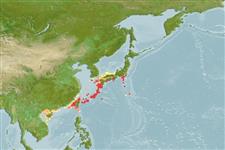>
Eupercaria/misc (Various families in series Eupercaria) >
Labridae (Wrasses) > Corinae
Etymology: Halichoeres: Greek, als, alis = salt + Greek, choiros = pig (Ref. 45335); orientalis: Named in reference to its occurrence in southern Japan and Taiwan (Ref. 31549).
More on author: Randall.
Environment: milieu / climate zone / depth range / distribution range
Ecología
marino asociado a arrecife; rango de profundidad 2 - 30 m (Ref. 31549). Subtropical
Distribución
Países | Áreas FAO | Ecosistemas | Ocurrencias, apariciones | Point map | Introducciones | Faunafri
Northwest Pacific: southern Japan and Taiwan.
Tamaño / Peso / Age
Maturity: Lm ? range ? - ? cm
Max length : 7.6 cm SL macho / no sexado; (Ref. 31549)
Short description
Morfología | Morfometría
Espinas dorsales (total): 9; Radios blandos dorsales (total): 12; Espinas anales 3; Radios blandos anales: 12; Vértebra: 25. Each lateral line scale with 2-4 tubules; without scales on cheek or opercle; without scales basally on dorsal or anal fins; a single pair of stout canines anteriorly in each jaw; a strong canine at corner of mouth; 9th dorsal spine longest, 2.75-3.1 in HL; green with 4 longitudinal salmon pink to orange bands on head, the 2nd and 3rd passing through eye, the 3rd bifurcating on opercle; a small vertically elongate black spot behind eye; upper 3 bands of head continuing as stripes anteriorly on body, and 2 more commencing from beneath pectoral fin, these stripes variously breaking into segments and forming 6 groups of irregular spots dorsally on body, the 2nd group in a dusky blotch; presumed male with this blotch black and containing small irregularly yellow spots; another presumed male phase blackish posteriorly to a vertical through base of 6th dorsal spine.
Life cycle and mating behavior
Madurez | Reproducción | Puesta | Huevos | Fecundidad | Larva
Distinct pairing during breeding (Ref. 205).
Randall, J.E., 1999. Halichoeres orientalis, a new labrid fish from southern Japan and Taiwan. Zool. Stud. 38(3):295-300. (Ref. 31549)
IUCN Red List Status (Ref. 130435)
Threat to humans
Harmless
Human uses
Más información
PaísesÁreas FAOEcosistemasOcurrencias, aparicionesIntroduccionesStocksEcologíaDietacomponentes alimenticiosconsumo de alimentoRación
Age/SizeCrecimientoLength-weightLength-lengthLength-frequenciesMorfometríaMorfologíaLarvaDinámica larvariaReclutamientoAbundanciaBRUVS
ReferenciasAcuiculturaPerfil de acuiculturaRazasGenéticaElectrophoresesheritabilidadEnfermedadesProcesamientoNutrientsMass conversion
ColaboradoresImágenesStamps, Coins Misc.SonidosCiguateraVelocidadTipo de nataciónSuperficie branquialOtolitosCerebrosVisión
Herramientas
Special reports
Download XML
Fuentes de Internet
Estimates based on models
Preferred temperature (Ref.
123201): 21.4 - 27.1, mean 24.9 °C (based on 176 cells).
Phylogenetic diversity index (Ref.
82804): PD
50 = 0.5000 [Uniqueness, from 0.5 = low to 2.0 = high].
Bayesian length-weight: a=0.00955 (0.00451 - 0.02020), b=3.09 (2.92 - 3.26), in cm total length, based on LWR estimates for this Genus-body shape (Ref.
93245).
Nivel trófico (Ref.
69278): 3.3 ±0.5 se; based on size and trophs of closest relatives
Resiliencia (Ref.
120179): Alto, población duplicada en un tiempo mínimo inferior a 15 meses (Preliminary K or Fecundity.).
Fishing Vulnerability (Ref.
59153): Low vulnerability (10 of 100).
Nutrients (Ref.
124155): Calcium = 86 [38, 193] mg/100g; Iron = 0.886 [0.457, 1.899] mg/100g; Protein = 19 [16, 21] %; Omega3 = 0.265 [0.138, 0.510] g/100g; Selenium = 10.1 [4.3, 22.6] μg/100g; VitaminA = 113 [30, 544] μg/100g; Zinc = 1.48 [0.87, 2.62] mg/100g (wet weight);
